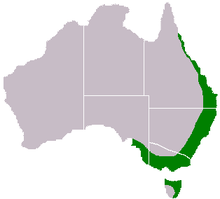Acacia melanoxylon
| Australian blackwood | |
|---|---|
 |
|
| Flowering twigs of Acacia melanoxylon | |
| Scientific classification | |
| Kingdom: | Plantae |
| (unranked): | Angiosperms |
| (unranked): | Eudicots |
| (unranked): | Rosids |
| Order: | Fabales |
| Family: | Fabaceae |
| Genus: | Acacia |
| Species: | A. melanoxylon |
| Binomial name | |
|
Acacia melanoxylon R.Br. |
|
 |
|
| Range of Acacia melanoxylon | |
| Synonyms | |
Acacia melanoxylon, commonly known as the Australian blackwood, is an Acacia species native in eastern Australia. The species is also known as Sally wattle, lightwood, hickory, mudgerabah, Tasmanian blackwood, black wattle or blackwood acacia.
Acacia melanoxylon is valued for its highly decorative timber which may be used as a cabinet timber, for musical instruments or in boatbuilding.
Sapwood may range in colour from straw to grey-white with clear demarcation from the heartwood. The heartwood is golden to dark brown with chocolate growth rings. The timber is generally straight grained but may be wavy or interlocked. Quartersawn surfaces may produce an attractive fiddleback figure. The wood is lustrous and possesses a fine to medium texture.
The name of the wood may refer to dark stains on the hands of woodworkers, caused by the high levels of tannin in the timber.
Acacia melanoxylon timber has a density of approximately 660 kg/m3 and is strong in compression, resistant to impact and is moderately stiff. It is moderately blunting to work with tools and bends well. It may be nailed or screwed with ease, but gluing may produce rather variable results. The wood may be stained easily and produces a high-quality finish.
Australian blackwood seasons easily with some possible cupping when boards are inadequately restrained. The timber produces very little movement once seasoned.
The timber may be attacked by furniture beetles, termites and powder-post beetles (sapwood). It is resistant to effective preservative treatments.
It has been introduced to many countries for forestry plantings and as an ornamental tree. It now is present in Africa, Asia, Europe, Indian Ocean, the Pacific Ocean, South America and the United States. It is a declared noxious weed species in South Africa and is a pest in Portugal's Azores Islands. It was also recently listed by the California Invasive Plant Council (Cal-IPC) as an invasive weed that may cause limited impact (Knapp 2003). Its use as a street tree is being phased out in some locales because of the damage it often causes to pavements and underground plumbing. In some regions of Tasmania, blackwood is now considered a pest.
Indigenous Australians derive an analgesic from the tree. It was also used to make spearthrowers and shields.
...
Wikipedia
